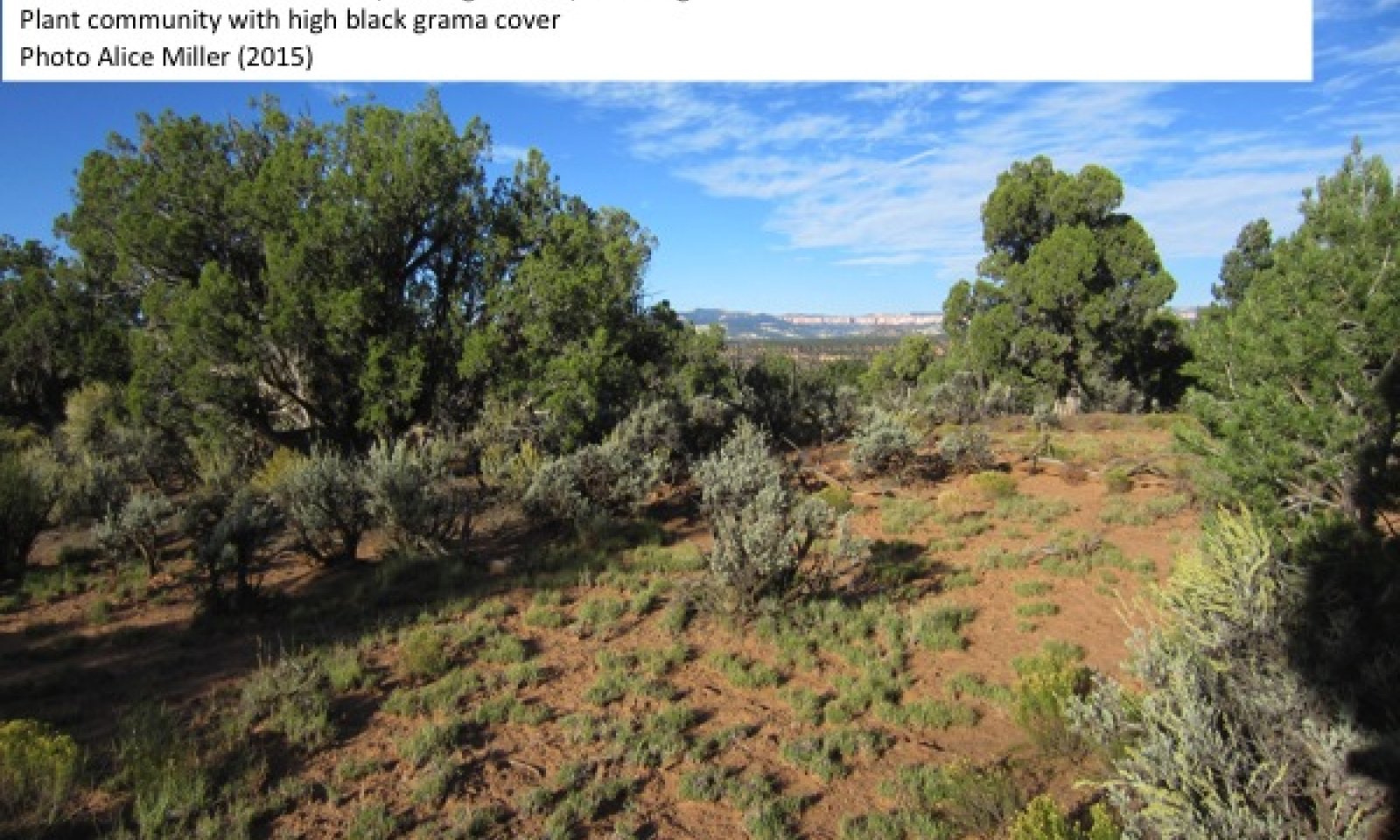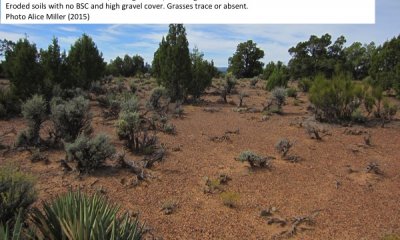
Semidesert Shallow Hardpan (Utah Juniper-Pinyon)
Scenario model
Current ecosystem state
Select a state
Management practices/drivers
Select a transition or restoration pathway
- Transition T1A More details
- Transition T2A More details
-
No transition or restoration pathway between the selected states has been described
Target ecosystem state
Select a state
Description
The reference state was determined by literature review, historical accounts, reports, and observations of trends in plant community dynamics.
The reference state represents the plant communities and ecological dynamics of this ecological site under pre-settlement conditions and a natural disturbance regime. The plant communities of the reference state were similar to those of the current potential state (State 2), with a quasi climax community characterized by an open canopy of Utah juniper and twoneedle pinyon, over an open shrub layer dominated by Wyoming big sagebrush and a productive perennial grass component. The grass component could have had different composition in the reference plant community, as both blue grama and James’ galleta may increase with grazing pressure, while less tolerant species like Indian ricegrass decline (Schmutz et al. 1967, Kleiner 1983, Tuhey and MacMahon 1988, Cole et al. 1997). Infrequent stand clearing fires would have created stands of shrublands and woodlands in different phases of succession. Non-native species were not present in the reference state. The species composition of the reference state BSC was likely different than in the current grazed state, with a higher proportion of lichens and mosses, and cover of BSC was probably greater. The primary disturbances included infrequent fire, fluctuations in precipitation, and native ungulate browsing. Plant communities will naturally shift among the three phases with very infrequent fire and climatic fluctuations.
Reference State: Plant communities influenced by fire, browse, and climate fluctuations between wet and dry periods.
Indicators: Dominance by Utah juniper and twoneedle pinyon with Wyoming big sagebrush and a productive perennial grass component, with stands of plant communities representing different phases of succession present over the landscape.
Feedbacks: Very infrequent stand-clearing fire and light browse pressure allows for a self-sustaining woodland with herbaceous and shrub successional phases.
At-risk Community Phase: All community phases are susceptible to severe impacts to BSC and soils from improper livestock grazing. Community phase 1.2 is particularly susceptible to invasion due to a lack of competition and extensive bare soil; however all phases are susceptible to invasion, especially with heavy grazing, browse or other disturbances that remove vegetative cover and disturb soils.
Trigger: Improper livestock grazing, and introduction of invasive species.
Submodel
Description
This state represents the current potential of this ecological site, and in addition to very infrequent fire and climate fluctuations, the dynamics include disturbance by livestock, which has caused significant erosion. The current potential state will naturally fluctuate between community phases 2.1 and 2.2, and will shift to community phase 2.3 with abusive livestock or recreational use. Continued abusive use, especially if coupled with severe drought, could cause a transition to an eroded state.
Current Potential State: Plant communities influenced by very infrequent fire, climate fluctuations between wet and dry periods, and livestock grazing.
Indicators: Dominance by Utah juniper and twoneedle pinyon with Wyoming big sagebrush and a productive perennial grass component, with stands of plant communities representing different phases of succession present over the landscape. Blue grama is the dominant grass, and James’ galleta is an important species. Broom snakeweed is a significant minor species in all communities. BSC cover is not continuous, and in community phase 1.3 may be absent over large areas.
Feedbacks: Very infrequent stand-clearing fire and light browse and grazing pressure allow for a self-sustaining woodland with herbaceous and shrub successional phases.
At-risk Community Phase: Community 2.4 is especially at risk of transitioning to an eroded state with continued abusive livestock use, especially if accompanied by severe drought.
Submodel
Description
This state is characterized by tree dominance with only trace herbaceous cover, loss of BSC and eroded soils.
Interpretive State: Plant communities influenced by soil erosion that inhibits recruitment, very infrequent fire and livestock grazing.
Indicators: Dominance by Utah juniper and twoneedle pinyon with decadent Wyoming big sagebrush in the shrub layer and virtually no herbaceous layer. Lack of BSC and high gravel cover.
Feedbacks: A soil surface inhospitable to vegetation recruitment and continued livestock grazing prevents a herbaceous component from establishing. Fire may be even more unlikely to occur in this phase due to the lack of fine fuels.
Submodel
Mechanism
Transition from reference state (State 1) to current potential state (State 2). This transition may occur with improper livestock use and introduction of invasive species.
Model keys
Briefcase
Add ecological sites and Major Land Resource Areas to your briefcase by clicking on the briefcase (![]() ) icon wherever it occurs. Drag and drop items to reorder. Cookies are used to store briefcase items between browsing sessions. Because of this, the number of items that can be added to your briefcase is limited, and briefcase items added on one device and browser cannot be accessed from another device or browser. Users who do not wish to place cookies on their devices should not use the briefcase tool. Briefcase cookies serve no other purpose than described here and are deleted whenever browsing history is cleared.
) icon wherever it occurs. Drag and drop items to reorder. Cookies are used to store briefcase items between browsing sessions. Because of this, the number of items that can be added to your briefcase is limited, and briefcase items added on one device and browser cannot be accessed from another device or browser. Users who do not wish to place cookies on their devices should not use the briefcase tool. Briefcase cookies serve no other purpose than described here and are deleted whenever browsing history is cleared.
Ecological sites
Major Land Resource Areas
The Ecosystem Dynamics Interpretive Tool is an information system framework developed by the USDA-ARS Jornada Experimental Range, USDA Natural Resources Conservation Service, and New Mexico State University.




